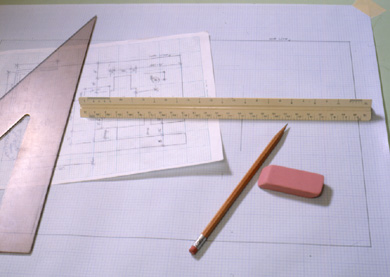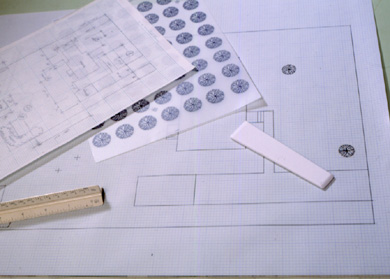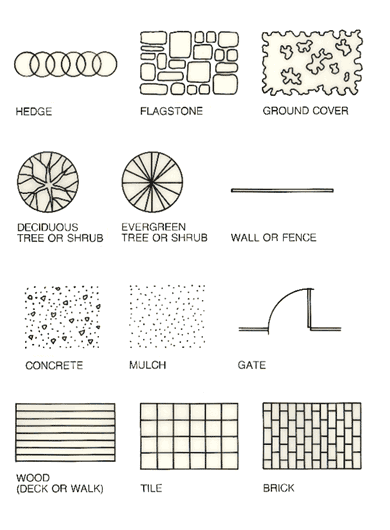






With a rough sketch of your property drawn and accurate figures gathered, you are well on the way to redesigning your yard's landscape. Now, go back inside and turn the rough sketch of your yard into a detailed, drawn-to-scale map. The sooner you do this, the fewer trips you'll have to make back out to recheck your measurements.
A drawing board and T-square will make the job easier, but they aren't essential. All you really need are any flat surface (a breadboard or large piece of cardboard makes a fine portable one) and a piece of paper large enough to draw your yard on. Most yards up to a half acre can be drawn on graph paper 18 to 24 inches square or vellum 17 to 22 inches square.
Use a scale of 1:4 (1 inch equals 4 feet or 1/4 inch equals 1 foot) for a small yard, down to 1:20 (1 inch equals 20 feet) for a half-acre lot. The larger the second number of the scale, the smaller everything will appear on paper.
Graph paper and vellum come with 4, 8, or 10 light grids per inch. These will not reproduce on a blueprint but will be helpful prior to that stage.
If your yard is very large, you may want to make one map of the whole yard at a small scale first, then later make separate plans of individual areas at a larger scale.
Find inspiration for your front yard landscaping design.
As an aid, you can use a professional scale. An architect's scale is calibrated in eighths of an inch, an engineer's in tenths. You can buy one scale that combines both. Or you can just use a ruler.
Tape your paper to your surface with a sturdy but removable tape such as masking tape.
 You can mark landscape features with press-on stickers, which you apply with a burnishing tool.
You can mark landscape features with press-on stickers, which you apply with a burnishing tool.
Draw an arrow pointing north. You can, of course, fill this in later, but it is best to have the north point to the top or side of your paper for quick reference. It will tell you a lot about the sun patterns and govern many plant and placing decisions.
Then, using a pencil, draw your map, starting with the property lines of the house and other structures. Measure a scale, compass, or ruler and make dots on the plan. Join them for lines.
 Use these standard symbols to
mark your map.
Click for more symbols.
Use these standard symbols to
mark your map.
Click for more symbols.
Mark the trunk positions of the trees and shrubs you plan to keep. You also may want to sketch in the present branch lines with thin but solid lines and keep the possible future spread lines in mind.
Once you complete your plan, make several photocopies or blueprint copies for you and any contractors to work with. Put the original in a safe place.
Having drawn your base map, you now have done more professional landscaping than most people ever accomplish. The next step is to tape a piece of tracing paper over your base plan and go outside again.
This time, on the tracing paper, make notes about your yard, similar to those shown below. Indicate any feature that may affect your landscape decisions: sun, wind, good and bad views, privacy needs, soil, topography, and any other problems or special features your yard presents. Put in arrows to indicate directions or intensity.
Also include here any notes about the adjoining properties that may be relevant to your plan: nearby trees, for example, or noise, erosion, or drainage problems.
Next, to make sure you fully analyze your lot, go back indoors. Check the views from the windows in the rooms where you spend the most time, and from your entryways, noting all the pluses and minuses of each view.
Get out any lists of likes and dislikes you've noted about your yard over the years. Write everything of importance on the tracing paper.
If you are doing this plan after studying your yard for a full cycle of seasons, you are ready to proceed. If not, the plan will help you notice more keenly how such features as sun, shadows, wind, and views change with the time of day and time of year. Put your plan in a handy spot so you can add to it as needed.
Only after doing such a plan can you put any landscaping ideas into the climate and context of your yard. Combine the possibilities with your own realities, and you will make decisions that will enhance the best and change the worst landscaping features.
Copyright © www.100flowers.win Botanic Garden All Rights Reserved